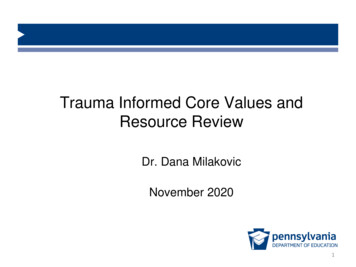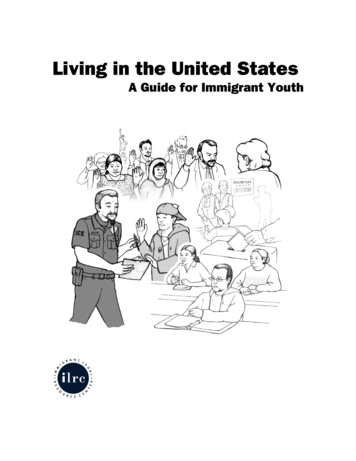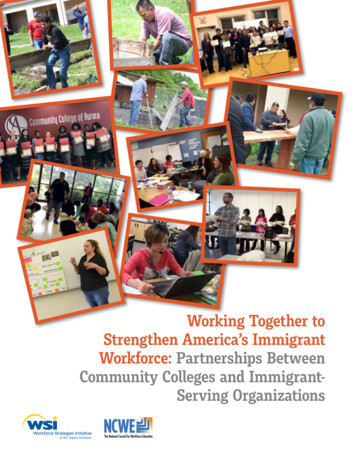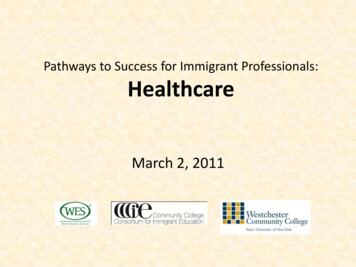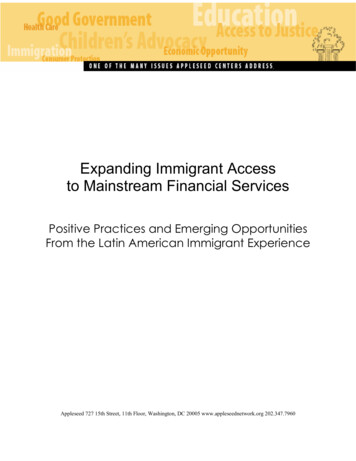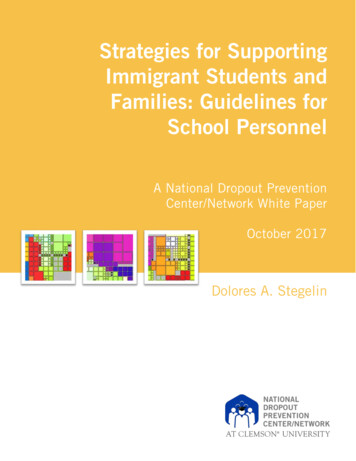
Transcription
Strategies for SupportingImmigrant Students andFamilies: Guidelines forSchool PersonnelA National Dropout PreventionCenter/Network White PaperOctober 2017Dolores A. Stegelin
Strategies forSupporting ImmigrantStudents andFamilies:Guidelines forSchool PersonnelA National Dropout Prevention Center/Network White PaperDolores A. Stegelin, PhDNational Dropout Prevention Center/Network Research Fellow andProfessor EmeritusClemson UniversityClemson, SC
2017 National Dropout Prevention Center/NetworkThis report is available as a pdf download or hard copy publication from tsCover image from Pixabay, by Gerd Altmann, https://pixabay.com/en/users/geralt-9301/, recolored andreleased under Creative Commons CC0 license.Suggested citation for report:Stegelin, D. A. (2017). Strategies for supporting immigrant students and families: Guidelines for schoolpersonnel [White paper]. Clemson, SC: National Dropout Prevention Center/Network. Retrieved 017-10.pdfNational Dropout Prevention Center/Network209 Martin Street Clemson University Clemson, SC 29631 864-656-2599ndpc@clemson.edu www.dropoutprevention.org
National Dropout Prevention Center/NetworkThe mission of the National Dropout Prevention Center/Network (NDPC/N) is to increasehigh school graduation rates and reduce school dropout rates through research, researchdissemination, and the provision of evidence-based solutions. It accomplishes these goals byserving as a clearinghouse and network for evidence-based information that supports dropoutprevention. The NDPC/N provides technical assistance and other professional assistance toschool districts in the United States, all in support of dropout prevention. Fifteen effectivestrategies (National Dropout Prevention Center/Network, n.d.) guide the work of the NDPC/N.This paper targets two of these strategies or subareas of strategies: Parent and FamilyEngagement and Strategies for Specific Populations. This publication is designed to inform andfacilitate best practices in school districts serving immigrant students and their families withinthe current context of increasing diversity and complex federal and state political environments.IMMIGRANT STUDENTS AND FAMILIES: AN OVERVIEWHistorically, schools in the“All children in the United States are entitled to equalUnited States have welcomed newaccess to a public elementary and secondary education,immigrant children to theirregardless of their or their parents’ actual or perceivedclassrooms, and according to recentnational origin, citizenship, or immigration status.”data, at the beginning of this decade(U.S. Department of Education, n.d.)there were nearly 900,000immigrant students in the UnitedStates, and more than 4.6 million English learners (U.S. Department of Education, n.d.). Thegrowing rate of immigration began decades ago, and during the 1970s and 1980s, 17 millionimmigrants entered the United States, more than double the number that had arrived during thefour preceding decades (Board on Children and Families, 1995). As the immigrant population inthe United States steadily has increased and diversified, so has the need for schools to supportthese students and their families. Over the past 40 years, the total foreign-born population in theUnited States has quadrupled, reaching 40 million people (12.9% of the total population) as of2010 (U.S. Census Bureau, 2014). About one in four children under the age of 18 in familieshave at least one foreign-born parent (Kids Count Data Center, 2017). And “while immigrantfamilies remain highly concentrated in ‘traditional gateway’ states such as California, there hasbeen a growing dispersion of immigrants to new areas, leading to significant increases inimmigrant populations in many small communities” (Dinan, 2006, p. 5).The U.S. Department of Education states that,All children in the United States are entitled to equal access to a public elementary andsecondary education, regardless of their or their parents’ actual or perceived nationalorigin, citizenship, or immigration status. This includes recently arrived andunaccompanied children who are in immigration proceedings while residing in localcommunities with a parent, family member, or other appropriate adult sponsor.(U.S. Department of Education, n.d.)Strategies for Supporting Immigrant Students and Families1
National Dropout Prevention Center/NetworkProviding school support for these immigrant students serves several purposes, includingacademic and socio-emotional support for the child, assisting the immigrant families, andfostering a collaborative home-school relationship that benefits everyone. Principals, teachers,and other school professionals can work to understand the issues and identify the resources,systems, and professional development necessary to meet the needs of immigrant students andtheir families (Elizalde-Utnick, 2010). Recent efforts to identify undocumented parents andchildren in the U.S. challenge the public schools in their efforts to meet the needs of all childrenresiding within their school districts. Public schools often find themselves in politically andlegally sensitive situations in which they must balance their responsibilities to serve immigrantand undocumented children and the expectation and need of local authorities to identifyundocumented individuals.This publication is provided to assist school district personnel in meeting the needs of allstudents—including undocumented children or children of undocumented parents—within theparameters of current legal guidelines in the United States.FEDERAL AND LEGAL GUIDELINES FOR SCHOOL DISTRICTSStates and school districts have anobligation to educate children whohave arrived in the United States.Public elementary and secondaryschools have a constitutional duty toprovide undocumented children witha free education—It’s the law.Even with a long history ofserving immigrant children in thepublic schools of the U.S., there arelimited examples of relevant litigationand court cases to provide context andinformation for public schooladministrators. Below are two keyquestions and responses relatedto current federal laws.1. Do States and school districts have an obligation to educate children who have arrivedto the United States? Yes. Under federal law, states and local educational agencies areobligated to provide all children—regardless of immigration status—with equal access to publiceducation at the elementary and secondary level. This includes children such as unaccompaniedchildren who may be involved in immigration proceedings.2. Do public elementary and secondary schools have a constitutional duty to provideundocumented children with a free education? Yes. The U.S. Supreme Court’s landmarkdecision in Plyler v. Doe established the principle that undocumented children have theconstitutional right under the Equal Protection Clause of the Fourteenth Amendment to receive afree public education from kindergarten to the 12th grade (Olivas, 2010). 2Under the law, the U. S. Department of Health and Human Services (HHS) is requiredto care for unaccompanied children apprehended while crossing the border. While incare at an HHS shelter, such children are not enrolled in local schools but do receiveeducational services and other care from providers who run HHS shelters.Strategies for Supporting Immigrant Students and Families
National Dropout Prevention Center/Network Recently arrived unaccompanied children are later released from federal custody to anappropriate sponsor—usually a parent, relative, or family friend—who can safely andappropriately care for them while their immigration cases proceed. While residing witha sponsor, these children have a right under federal law to enroll in public elementaryand secondary schools in their local communities and to benefit from educationalservices, as do all children in the U.S. (U.S. Department of Education, n.d.)MAJOR ISSUES FOR IMMIGRANT STUDENTS, PARENTS, AND FAMILIESAs the immigrant population in the United StatesAs the immigrant population in theincreases, so does the need for schools to supportU.S. increases, so does the needimmigrant students and their families. Principals andfor schools to support immigrantother administrators can work with their student supportstudents and their families.personnel—school psychologists, counselors, socialworkers, nurses, and teachers—to understand the issuesand identify the resources, systems, and professional development necessary to meet the needs ofimmigrant students and their families (Olivas, 2010). Following are key issues for immigrantstudents, parents, families, and for the school-based personnel who serve them.KEY ISSUES FOR ELEMENTARY AND SECONDARY STUDENTSThe majority of immigrant and undocumented children attend public elementary andsecondary schools in the U.S. With the expansion of 4K programs in public schools, very youngchildren are also found in large numbers in elementary school settings, bringing with themunique emotional, social, and cognitive needs (Morrison, 2013). Each child brings to the schoola unique profile of strengths and needs that deserves to be supported. Circumstances for thesechildren range widely, from economic, language, educational, health, cultural, and religiousperspectives.The following is a list of common issues for immigrant elementary and secondary students: acculturation challenges and exposure to racism and discrimination contributing toidentity confusion, especially for adolescentsaccessibility and transportation to the public schools and school resourcessocial pressures to fit in and assimilate into the school culturestress related to undocumented parents and the fear of deportationpart-time employment to provide income to the family due to family economic distressor a parent being deportedserving multiple roles related to parents, siblings, and as a student in the schoolsrestricted social interaction within the school environment due to family responsibilitiesor parents’ restrictionsincreased absenteeism due to family responsibilities or stress-related illnessesdrops in grades and ability to keep up with homework and school expectationsStrategies for Supporting Immigrant Students and Families3
National Dropout Prevention Center/Network symptoms of depression, anxiety, and other psychological and stress-related healthissuesvarying levels of English language proficiency for the student and parentsdiverse economic backgrounds and resourcesidentifying with negative stereotypes that can cause the student to withdraw from schoolsocially and emotionally, perform poorly, and adopt negative behaviorsKEY ISSUES FOR PARENTS AND FAMILIESSupporting immigrant familiesincludes support to meet immigrantstudents’ learning needs.Supporting immigrant families includes homeschool collaboration, linking families with school-basedand community services, and providing specificinstructional support to meet immigrant students’learning needs.Key issues experienced by immigrant parents and families include the following: 4lack of access to, or skills for, consistent employment, often resulting in inadequateincome to support familieslimited access to health care and prenatal care services, federally or locally fundedhealth and prenatal care insurance, and government programs for their families(Dinan 2006)fear of deportation or being the remaining parent to care for a family due to deportationof the other parentlimited English proficiency and/or confidence to communicate with school officialslack of high school education or equivalency to compete for jobsacculturation and fitting into American schools and neighborhoods (Olivas, 2010;Hwang, 2006)living in hostile communities that may not support federal and local governmentprograms for immigrantsanxiety, depression, and other psychologically related health issues (Dinan, 2006;Hwang, 2006)relational stress within the family and/or with the children’s schoolsanticipatory distress as undocumented parents make plans for the caring of theirchildren by other relatives and loved ones, in case the parents are deported(Hwang, 2006)Strategies for Supporting Immigrant Students and Families
National Dropout Prevention Center/NetworkKEY ISSUES FOR PRINCIPALS, TEACHERS, AND OTHER PROFESSIONALSPublic school personnel serving immigrant children and families face daily challenges inmeeting the academic, social-emotional, and familial needs of this population.Key issues for principals, teachers, and other professionals include the following: staying vigilant and identifying immigrant students and families who are experiencingextreme stress in their lives (Hwang, 2006)scheduling time to spend with immigrant students to listen and to take a personalinterest in their individual issuesproviding appropriate resources for immigrant students and families in a culturallyresponsive and sensitive manner, including basic information about community-basedagencies and health, food, shelter, economic, educational, and employment needs(Dinan, 2006; Elizalde-Utnick, 2010)becoming fluent in the languages spoken by immigrant children in the school andbuilding rapport and relationships with individual students and their parentsproviding culturally responsive assessment of individual immigrant student’s Englishlanguage proficiency, academic readiness, strengths, and areas of concernmeeting immigrant students and their parents at their points of readiness, includingmeeting with them off campus and in community sites where the family may feel safeand comfortableidentifying students who are in crisis and reaching out to them and their parents in aconfidential and trustworthy manner, and providing appropriate school-based servicesthrough school psychologists, counselors, social workers, nurses, and other personnel(Morrison 2013; Hwang 2006)building school personnel teams that work together to meet the needs of individualimmigrant students and their families (These teams should reflect the unique needs ofeach student and can include a teacher, psychologist, special education coordinator,parent, social worker, and other individuals as needed.)SCHOOL-BASED STRATEGIES FOR TEACHERS, ADMINISTRATORS, ANDPROFESSIONAL STAFFPublic schools are complex environments in which all aspects of children’s developmentalneeds are addressed. Elementary and secondary schools frequently become the most secureplaces for young immigrant children, and they often provide basic food, shelter, and relationshipneeds, especially when home environments are stressed and unpredictable. School personnelfrequently are the immigrant child’s most reliable and consistent source of adult relationshipsand comfort (Morrison, 2013; Hwang, 2006).Meeting the needs of such diverse immigrant child and family situations requiresknowledge, commitment, and emotional energy on the parts of school administrators, teachers,Strategies for Supporting Immigrant Students and Families5
National Dropout Prevention Center/Networkand other school personnel. School professionals shouldPreparation for public schoolbe poised to provide assistance to immigrant families in aadministrators, teachers and otherculturally competent manner. “Cultural competenceprofessional personnel involvesentails a three-pronged approach: self-awareness,self-awareness, knowledge ofknowledge of other cultures, and skill” (Elizalde-Utnick,other cultures, and skills.2010, p. 14). While some states have become the homebase for the majority of immigrant children and families,the fact is that public elementary and secondary schools in most states in the U.S. are now hometo immigrant students and families. Thus there is a need to help prepare public schooladministrators, teachers, and other professional personnel to embrace and support this veryimportant part of the school community: immigrant children and families. Being prepared tomeet these needs takes time, commitment, and a shared vision of the school. Being ready tomeet the needs of immigrant students also takes place over time and is a dynamic process withmultiple opportunities for input, output, and improvement.The following are strategies for school personnel to follow in meeting the needs ofimmigrant students and families: 6Find ways to enhance and achieve your own self-awareness of your cultural heritageand the values that are embedded. One must understand one’s own heritage in order tobe culturally responsive to others’ heritages and values.Promote, facilitate, and participate in activities that increase knowledge of the culturesrepresented within the school through focused study of the values, living habits, food,family traditions, and other aspects of those cultures and the lives of students withinthe school.Request and assist school administrators in providing professional development forteachers and other school personnel related to the cultures reflected in the studentpopulation.Become skilled in conversational languages spoken in the school setting, with anemphasis on learning to speak Spanish fluently.Establish collaborative relationships. Reaching out and attempting to collaborate withstudents and families is the first step.Remember that immigrant families might not share a philosophy of active participationin and partnership with schools (Elizalde-Utnick, 2010). Some may view the teacherand the school as the main authority for the child.Provide support services for immigrant families. School personnel—particularly schoolpsychologists, social workers, counselors, and family liaisons—should work together.These school personnel are greatly instrumental in helping meet the needs of immigrantchildren and parents.Establish a menu of parent and family support services that can include orientation programs for new immigrants, free and reduced-price breakfast and lunch programs,Strategies for Supporting Immigrant Students and Families
National Dropout Prevention Center/Network after-school childcare programs that provide homework support, family involvement programs that support the development of reading andmathematical reasoning, family literacy programs that support ELL learners—parents and children—andencourage shared reading at home, parenting workshops and parent support groups, increased access to health services regardless of immigration status (Dinan 2006), ESL classes for parents, school interpreters, community-based and culturally-based social service agencies (Elizalde-Utnick,2010; Dinan, 2006), steps to facilitate immigrants’ access to banks and other financial institutions, and addressing the barriers that prevent low-income immigrant families from receivingpublic benefits (Dinan, 2006).Instructional planning for ELLs should make use of differentiated instruction strategiesthat take into account students’ readiness levels, learning style preferences, languagedominance, and interests. Strategies include previewing key academic vocabulary before each lesson, scaffolding important concepts, contextualizing vocabulary, providing photo illustrations and manipulatives, providing support or scaffolding materials in the students’ first language, and teaching concepts and vocabulary in the students’ first language through acommunity volunteer or a proficient bilingual peer (Elizalde-Utnick, 2010).In addition, immigrant students can benefit fromclassroom activities and schedules that encourage selfregulation. Many immigrant students have beenimmersed in chaotic and uncertain circumstances in thetransition into the United States, and they benefit fromroutines and structure that build a sense of rhythm andsecurity. The social-emotional needs of these children isequally as important as their academic needs. Indeed,Maslow’s theory informs of the important need toaddress children’s basic needs before we can expectacademic engagement and performance (Morrison,2013). In order to be effective, public school personnelmust have a shared and common vision for theimmigrant child and family population.Maslow’s theory stresses theimportance of addressingchildren’s basic needs beforewe can expect academicengagement andperformance.Strategies for Supporting Immigrant Students and FamiliesSelf-Fulfillment NeedsAffective NeedsPhysical (Basic) Needs7
National Dropout Prevention Center/NetworkSUMMARYImmigrant families are a very diverse group and face a number of challenges depending onhow and under what circumstances they arrive in the United States. School professionals are in aposition to offer assistance and services to immigrant students and families in need, includinghome-school collaboration, school- and community-based services, and instructional support.Immigrant students can also benefit from social-emotional support services and multiculturalvocational interventions. By providing support to immigrant families and students in need,schools ensure that immigrant students not only develop a sense of belonging but also learn in anenvironment that fosters respect, success, and achievement for all.8Strategies for Supporting Immigrant Students and Families
National Dropout Prevention Center/NetworkREFERENCESBoard on Children and Families, Commission on Behavioral and Social Sciences and Education,National Research Council, Institute of Medicine. (Summer/Fall, 1995). Immigrant childrenand their families: Issues for research and policy, The Future of Children, 5(2), 72–89.Retrieved from tions/docs/05 02 06.pdfDinan, K. A. (May 2006). Young children in immigrant families—The role of philanthropy:Sharing knowledge, creating services, and building supportive policies [Report of ameeting, January 18–19, 2006]. New York: National Center for Children in Poverty.Columbia University Academic Commons. https://doi.org/10.7916/D87W6MX0Elizalde-Utnick, G. (January, 2010). Immigrant families: Strategies for school support, PrincipalLeadership, 10(5), 12–16. Retrieved ucators/Immigrant FamiliesJan10 NASSP.pdfHwang, W. C. (2006). Acculturative family distancing: Theory, research, and clinical practice.Psychotherapy: Theory, Research, Practice, Training, 43(4), 397–409.Kids Count Data Center. (2017). Children in immigrant families. U.S. data from 2011–2015provided by National Kids Count. Baltimore, MD: Annie E. Casey Foundation. Retrievedfrom ildren-in-immigrantfamilies?loc 1&loct 446Morrison, G. (2013). Early childhood education today (13th ed.). Columbus, OH: PearsonPublishing.National Dropout Prevention Center/Network. (n.d.). Effective strategies. Clemson, SC: NationalDropout Prevention Center/Network at Clemson University. Retrieved Olivas, M. A. (September 2010). Plyler v. Doe: Still guaranteeing unauthorized immigrantchildren’s rights to attend U.S. public schools. Washington, DC: Migration Policy Institute.Retrieved from ns-right-attend-us-publicU.S. Census Bureau. (2014). The “Second Great Wave” of immigration: Growth of the foreignborn population since 1970 [Visualization]. Retrieved .S. Department of Education. (n.d.). Educational services for immigrant children and thoserecently arrived to the United States [Factsheet]. Ed.gov. Retrieved fromwww.ed.gov/unaccompaniedchildrenFor help with additional questions regarding resources for unaccompanied children, pleasecall the U.S. Department of Education at 800-USA-LEARN or visit https://answers.ed.govStrategies for Supporting Immigrant Students and Families9
National Dropout Prevention Center/Network209 Martin Street Clemson, SC 29631 864-656-2599ndpc@clemson.edu www.dropoutprevention.org
209 Martin Street Clemson University Clemson, SC 29631 864-656-2599 ndpc@clemson.edu www.dropoutprevention.org 2017 National Dropout Prevention Center/Network . . health and prenatal care insurance, and government programs for their families (Dinan 2006)

